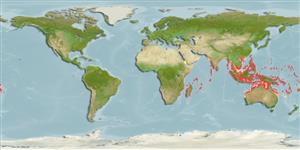Common names from other countries
Environment: milieu / climate zone / depth range / distribution range
生態学
海; 新鮮な水; 汽水性の 底生の; 降流性の (Ref. 51243). Tropical; 22°N - 27°S
Indo-Pacific: widespread in the tropical Indian Ocean and western Pacific. Known in Australia only from streams in the Kimberley regions of northern western Australia. Africa: widespread but relatively uncommon along east and southeast African coast and Madagascar (Ref. 7248, 52193). Mozambique; Lower Zambezi River (Ref. 39494). Most easily confused with Anguilla obscura and the surest way to distinguish them is by the count of vertebrae (Ref. 9828).
サイズ / 重さ / 年齢
Maturity: Lm ? range ? - ? cm
Max length : 123 cm TL オス/雌雄の選別がない; (Ref. 6371); common length : 65.0 cm TL オス/雌雄の選別がない; (Ref. 2871); 最大記録サイズ: 20 年 (Ref. 48660)
背面の脊椎 (合計) : 0; 背鰭 (合計) : 240 - 245; 肛門の骨: 0; 臀鰭: 200 - 220; 脊つい: 105 - 115.
Migratory species which breeds in the ocean (Ref. 52331, 79840). Lives in fresh water areas as an adult, in estuaries and seas as young (Ref. 12693). Descends to the sea to spawn. Inhabits freshwater streams and pools, preferring marshy habitats (Ref. 41236). Found in rivers and creeks, commonly over rock bottoms and in deeper pools. Seldom occurs in large rivers (Ref. 6028). Restricted to lowland (coastal) reaches of river systems (Ref. 7248). Feeds on small fishes, crustaceans and mollusks. Reported to breed east of Madagascar; the south equatorial current probably carries the eel larvae and elvers towards the east coast of Africa where local coastal currents guide the elvers to suitable rivers which they invade and they stay there until sexually mature, when they return to their breeding grounds (Ref. 13337). Caught with various types of nets. Sometimes used in the aquarium trade (Ref. 6028).
Life cycle and mating behavior
Maturities | 繁殖 | Spawnings | Egg(s) | Fecundities | 幼生
Kottelat, M., 2013. The fishes of the inland waters of Southeast Asia: a catalogue and core bibliography of the fishes known to occur in freshwaters, mangroves and estuaries. The Raffles Bulletin of Zoology 2013 (Suppl. 27):1-663. (Ref. 94476)
CITES (Ref. 128078)
Not Evaluated
Human uses
水産業: 少数商業の
用具
特記事項
XMLをダウンロードして下さい
インターネットの情報源
Estimates based on models
Preferred temperature (Ref.
115969): 26.5 - 29.1, mean 28.3 (based on 1098 cells).
Phylogenetic diversity index (Ref.
82804): PD
50 = 0.5000 [Uniqueness, from 0.5 = low to 2.0 = high].
Bayesian length-weight: a=0.00076 (0.00037 - 0.00155), b=3.17 (3.00 - 3.34), in cm Total Length, based on LWR estimates for this Genus-body shape (Ref.
93245).
栄養段階 (Ref.
69278): 3.6 ±0.50 se; based on food items.
回復力 (Ref.
120179): 低い, 4.5年~14年の倍増期間の最小個体群 (tmax=20).
Fishing Vulnerability (Ref.
59153): High to very high vulnerability (74 of 100).
